Sustainable Technology and Management in Cars Service Workshop Report
VerifiedAdded on 2021/06/16
|15
|3615
|19
Report
AI Summary
This report delves into the realm of sustainable technology within the context of a car service workshop. It meticulously examines key areas such as energy consumption, water usage, the lifecycle of products, and the implementation of green business practices. The report provides a comprehensive overview of sustainable technologies, including tidal energy, smart monitoring, bioplastics, and nanotechnology. Furthermore, it defines and explores the concept of a green business, highlighting the importance of minimizing environmental impact while maintaining profitability. The report also presents a business sustainability audit, outlining a roadmap for assessing and improving sustainability practices. It details short-term costs and long-term benefits associated with sustainability initiatives, emphasizing the significance of employee participation and the avoidance of greenwashing. The report then focuses on the life cycle of tires, from composition and manufacturing to environmental impacts and sustainability strategies, including waste management techniques like recycling and innovative approaches to reduce environmental impact. Finally, it addresses energy consumption processes within the workshop, identifying areas for improvement and energy efficiency.
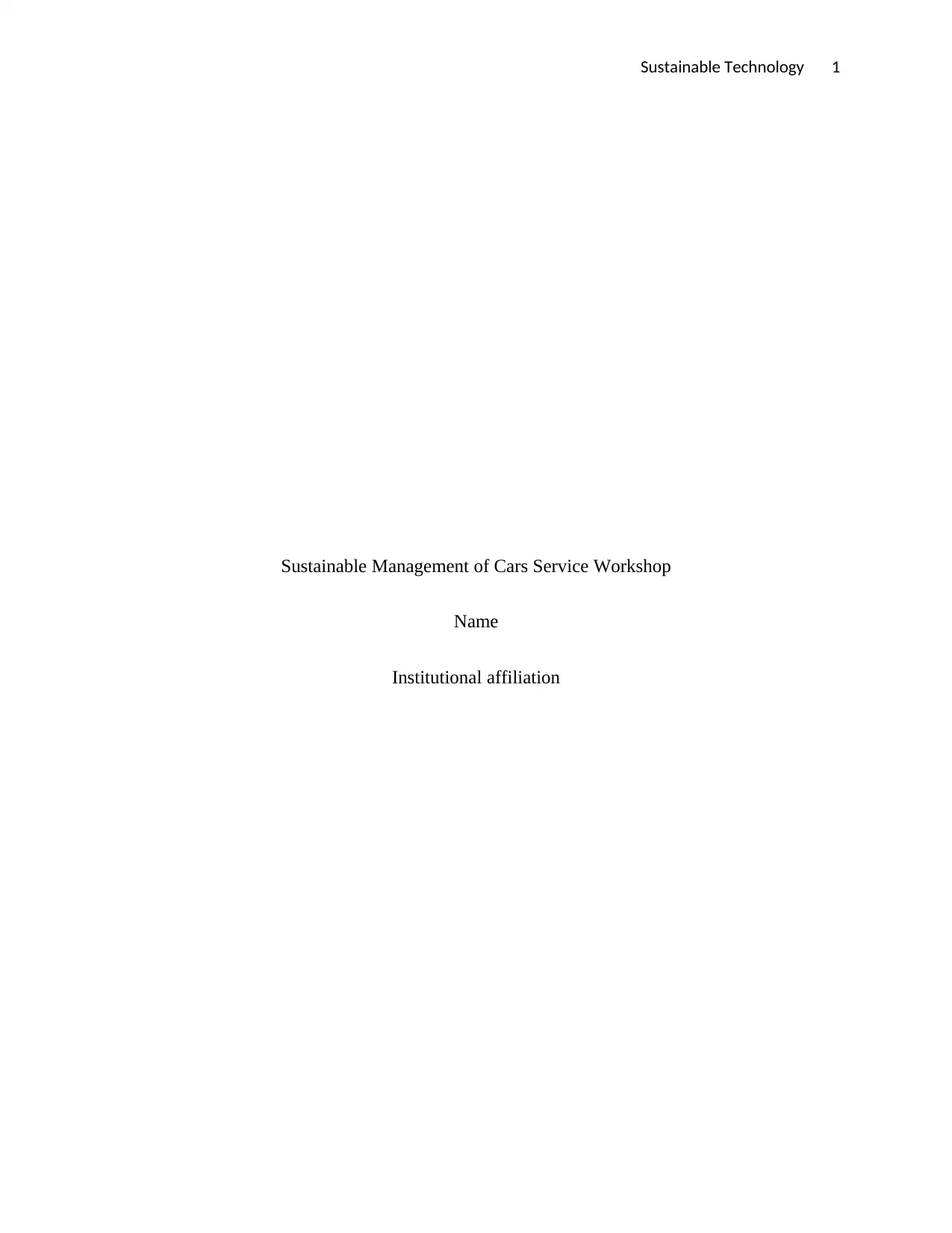
Sustainable Technology 1
Sustainable Management of Cars Service Workshop
Name
Institutional affiliation
Sustainable Management of Cars Service Workshop
Name
Institutional affiliation
Paraphrase This Document
Need a fresh take? Get an instant paraphrase of this document with our AI Paraphraser
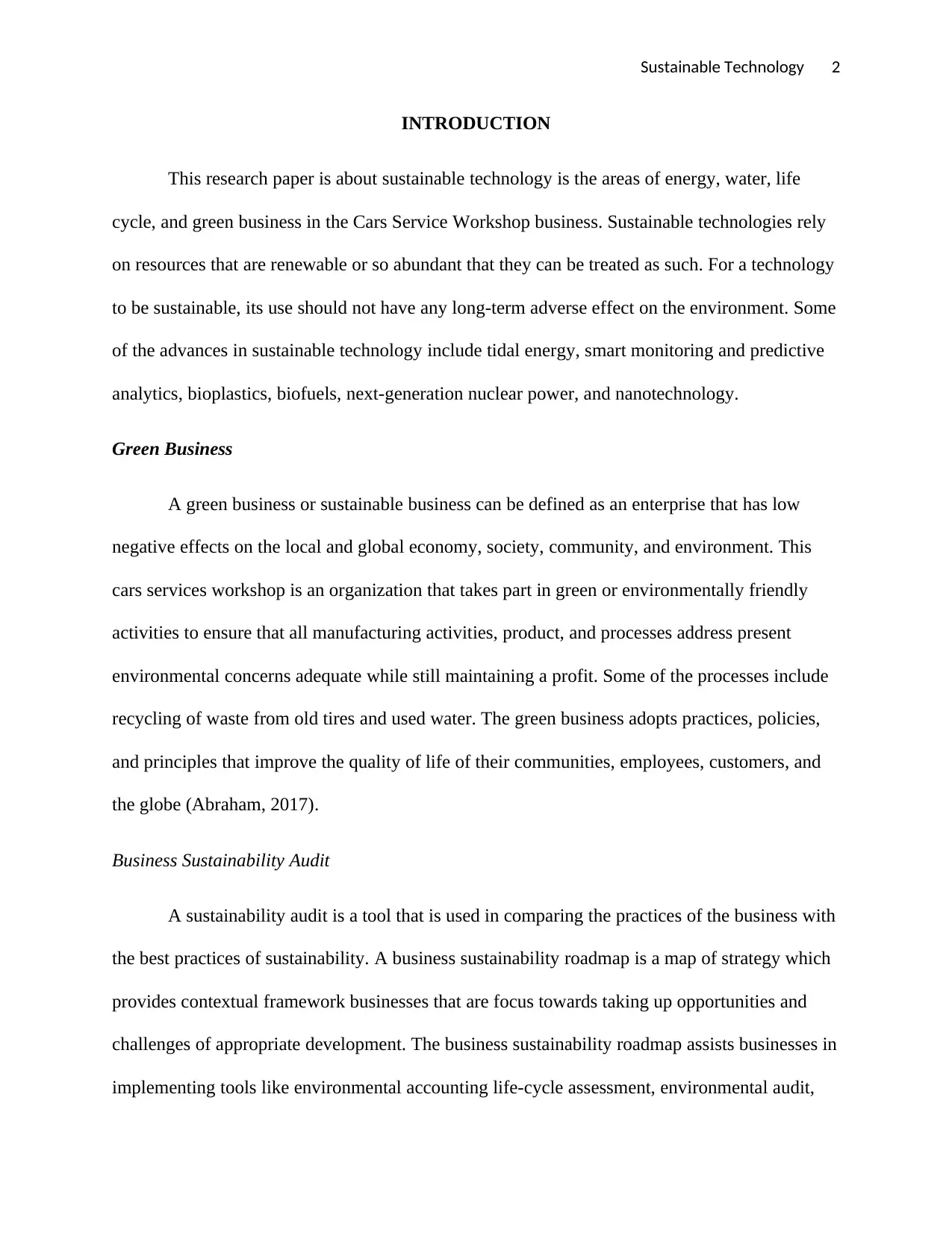
Sustainable Technology 2
INTRODUCTION
This research paper is about sustainable technology is the areas of energy, water, life
cycle, and green business in the Cars Service Workshop business. Sustainable technologies rely
on resources that are renewable or so abundant that they can be treated as such. For a technology
to be sustainable, its use should not have any long-term adverse effect on the environment. Some
of the advances in sustainable technology include tidal energy, smart monitoring and predictive
analytics, bioplastics, biofuels, next-generation nuclear power, and nanotechnology.
Green Business
A green business or sustainable business can be defined as an enterprise that has low
negative effects on the local and global economy, society, community, and environment. This
cars services workshop is an organization that takes part in green or environmentally friendly
activities to ensure that all manufacturing activities, product, and processes address present
environmental concerns adequate while still maintaining a profit. Some of the processes include
recycling of waste from old tires and used water. The green business adopts practices, policies,
and principles that improve the quality of life of their communities, employees, customers, and
the globe (Abraham, 2017).
Business Sustainability Audit
A sustainability audit is a tool that is used in comparing the practices of the business with
the best practices of sustainability. A business sustainability roadmap is a map of strategy which
provides contextual framework businesses that are focus towards taking up opportunities and
challenges of appropriate development. The business sustainability roadmap assists businesses in
implementing tools like environmental accounting life-cycle assessment, environmental audit,
INTRODUCTION
This research paper is about sustainable technology is the areas of energy, water, life
cycle, and green business in the Cars Service Workshop business. Sustainable technologies rely
on resources that are renewable or so abundant that they can be treated as such. For a technology
to be sustainable, its use should not have any long-term adverse effect on the environment. Some
of the advances in sustainable technology include tidal energy, smart monitoring and predictive
analytics, bioplastics, biofuels, next-generation nuclear power, and nanotechnology.
Green Business
A green business or sustainable business can be defined as an enterprise that has low
negative effects on the local and global economy, society, community, and environment. This
cars services workshop is an organization that takes part in green or environmentally friendly
activities to ensure that all manufacturing activities, product, and processes address present
environmental concerns adequate while still maintaining a profit. Some of the processes include
recycling of waste from old tires and used water. The green business adopts practices, policies,
and principles that improve the quality of life of their communities, employees, customers, and
the globe (Abraham, 2017).
Business Sustainability Audit
A sustainability audit is a tool that is used in comparing the practices of the business with
the best practices of sustainability. A business sustainability roadmap is a map of strategy which
provides contextual framework businesses that are focus towards taking up opportunities and
challenges of appropriate development. The business sustainability roadmap assists businesses in
implementing tools like environmental accounting life-cycle assessment, environmental audit,
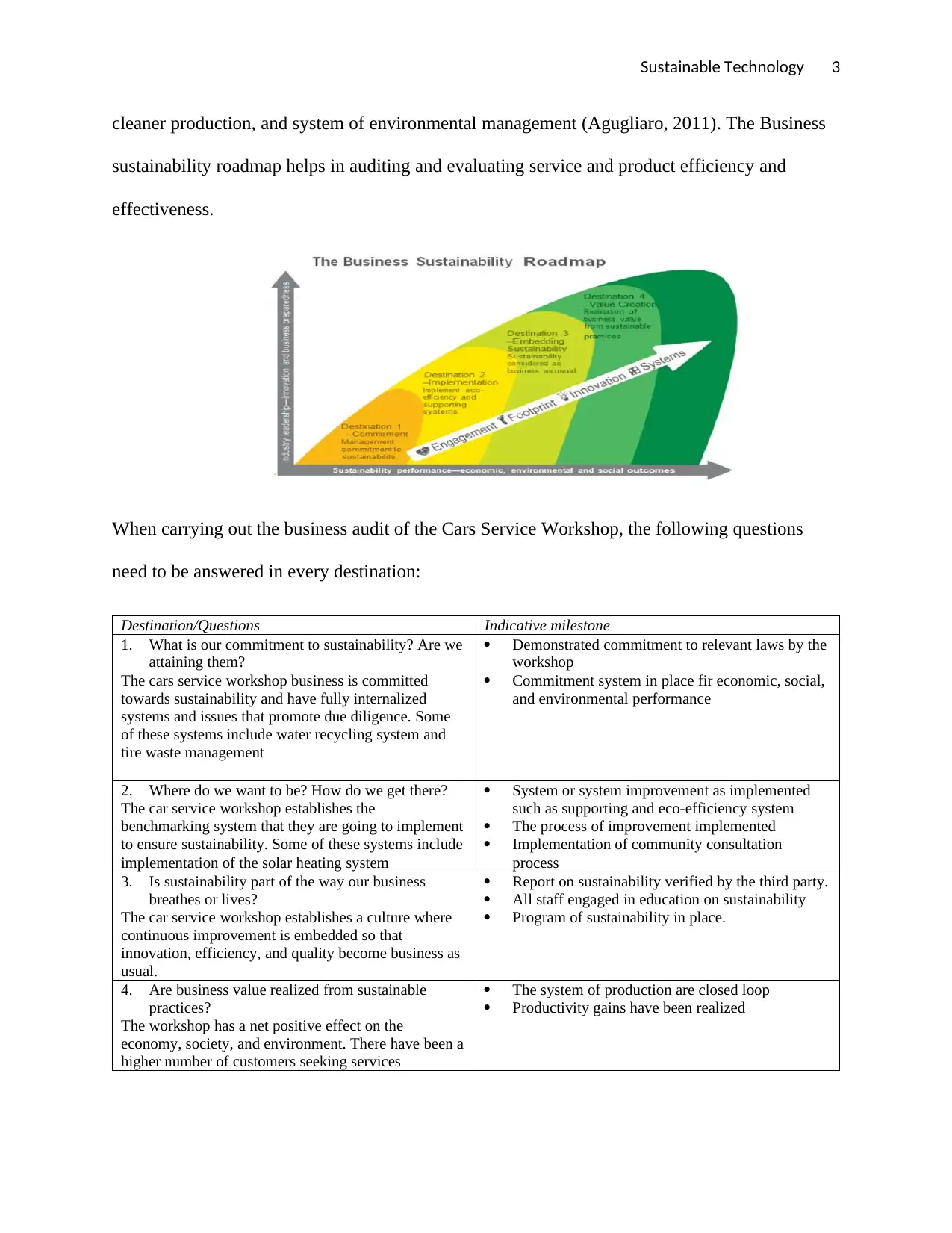
Sustainable Technology 3
cleaner production, and system of environmental management (Agugliaro, 2011). The Business
sustainability roadmap helps in auditing and evaluating service and product efficiency and
effectiveness.
When carrying out the business audit of the Cars Service Workshop, the following questions
need to be answered in every destination:
Destination/Questions Indicative milestone
1. What is our commitment to sustainability? Are we
attaining them?
The cars service workshop business is committed
towards sustainability and have fully internalized
systems and issues that promote due diligence. Some
of these systems include water recycling system and
tire waste management
Demonstrated commitment to relevant laws by the
workshop
Commitment system in place fir economic, social,
and environmental performance
2. Where do we want to be? How do we get there?
The car service workshop establishes the
benchmarking system that they are going to implement
to ensure sustainability. Some of these systems include
implementation of the solar heating system
System or system improvement as implemented
such as supporting and eco-efficiency system
The process of improvement implemented
Implementation of community consultation
process
3. Is sustainability part of the way our business
breathes or lives?
The car service workshop establishes a culture where
continuous improvement is embedded so that
innovation, efficiency, and quality become business as
usual.
Report on sustainability verified by the third party.
All staff engaged in education on sustainability
Program of sustainability in place.
4. Are business value realized from sustainable
practices?
The workshop has a net positive effect on the
economy, society, and environment. There have been a
higher number of customers seeking services
The system of production are closed loop
Productivity gains have been realized
cleaner production, and system of environmental management (Agugliaro, 2011). The Business
sustainability roadmap helps in auditing and evaluating service and product efficiency and
effectiveness.
When carrying out the business audit of the Cars Service Workshop, the following questions
need to be answered in every destination:
Destination/Questions Indicative milestone
1. What is our commitment to sustainability? Are we
attaining them?
The cars service workshop business is committed
towards sustainability and have fully internalized
systems and issues that promote due diligence. Some
of these systems include water recycling system and
tire waste management
Demonstrated commitment to relevant laws by the
workshop
Commitment system in place fir economic, social,
and environmental performance
2. Where do we want to be? How do we get there?
The car service workshop establishes the
benchmarking system that they are going to implement
to ensure sustainability. Some of these systems include
implementation of the solar heating system
System or system improvement as implemented
such as supporting and eco-efficiency system
The process of improvement implemented
Implementation of community consultation
process
3. Is sustainability part of the way our business
breathes or lives?
The car service workshop establishes a culture where
continuous improvement is embedded so that
innovation, efficiency, and quality become business as
usual.
Report on sustainability verified by the third party.
All staff engaged in education on sustainability
Program of sustainability in place.
4. Are business value realized from sustainable
practices?
The workshop has a net positive effect on the
economy, society, and environment. There have been a
higher number of customers seeking services
The system of production are closed loop
Productivity gains have been realized
⊘ This is a preview!⊘
Do you want full access?
Subscribe today to unlock all pages.

Trusted by 1+ million students worldwide
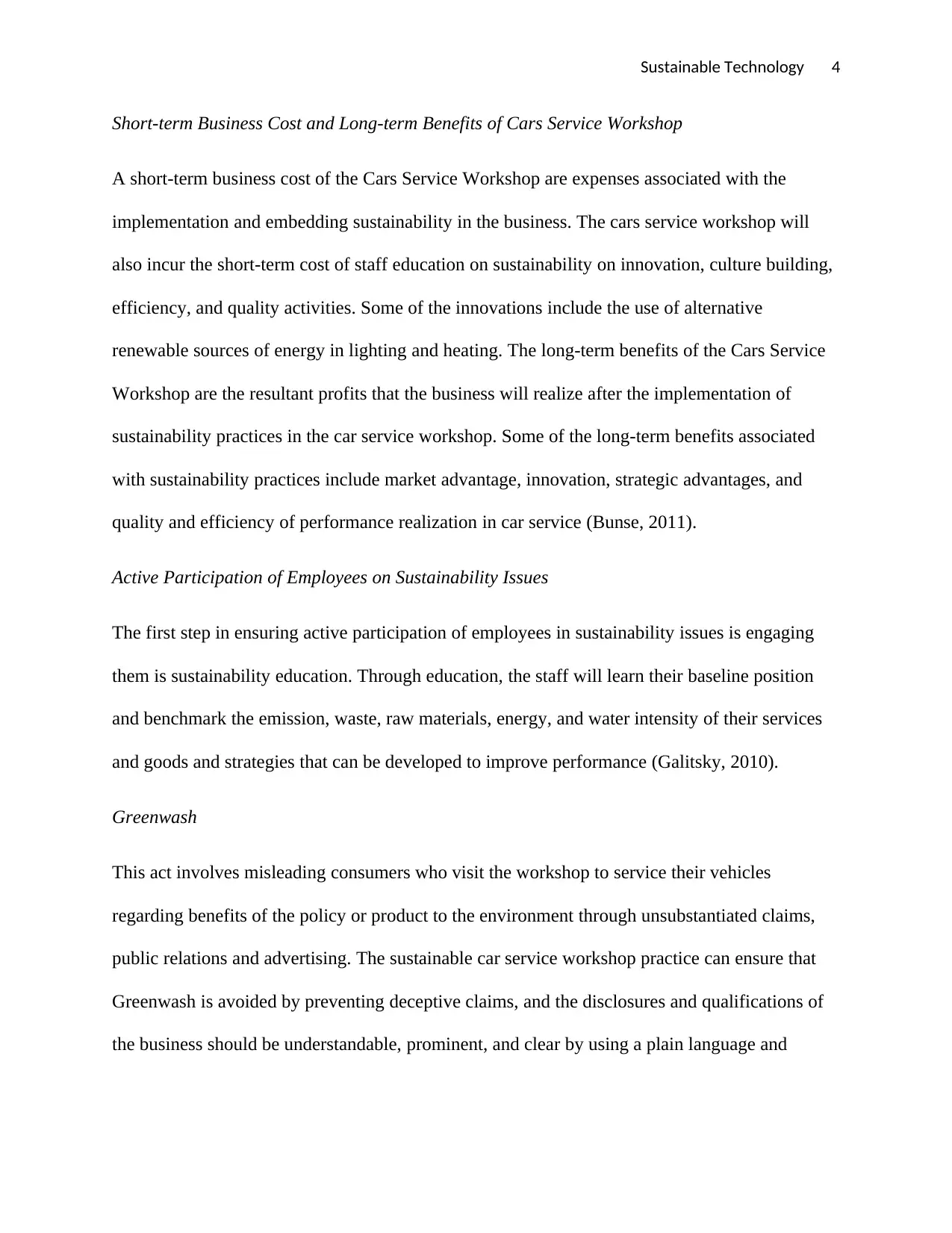
Sustainable Technology 4
Short-term Business Cost and Long-term Benefits of Cars Service Workshop
A short-term business cost of the Cars Service Workshop are expenses associated with the
implementation and embedding sustainability in the business. The cars service workshop will
also incur the short-term cost of staff education on sustainability on innovation, culture building,
efficiency, and quality activities. Some of the innovations include the use of alternative
renewable sources of energy in lighting and heating. The long-term benefits of the Cars Service
Workshop are the resultant profits that the business will realize after the implementation of
sustainability practices in the car service workshop. Some of the long-term benefits associated
with sustainability practices include market advantage, innovation, strategic advantages, and
quality and efficiency of performance realization in car service (Bunse, 2011).
Active Participation of Employees on Sustainability Issues
The first step in ensuring active participation of employees in sustainability issues is engaging
them is sustainability education. Through education, the staff will learn their baseline position
and benchmark the emission, waste, raw materials, energy, and water intensity of their services
and goods and strategies that can be developed to improve performance (Galitsky, 2010).
Greenwash
This act involves misleading consumers who visit the workshop to service their vehicles
regarding benefits of the policy or product to the environment through unsubstantiated claims,
public relations and advertising. The sustainable car service workshop practice can ensure that
Greenwash is avoided by preventing deceptive claims, and the disclosures and qualifications of
the business should be understandable, prominent, and clear by using a plain language and
Short-term Business Cost and Long-term Benefits of Cars Service Workshop
A short-term business cost of the Cars Service Workshop are expenses associated with the
implementation and embedding sustainability in the business. The cars service workshop will
also incur the short-term cost of staff education on sustainability on innovation, culture building,
efficiency, and quality activities. Some of the innovations include the use of alternative
renewable sources of energy in lighting and heating. The long-term benefits of the Cars Service
Workshop are the resultant profits that the business will realize after the implementation of
sustainability practices in the car service workshop. Some of the long-term benefits associated
with sustainability practices include market advantage, innovation, strategic advantages, and
quality and efficiency of performance realization in car service (Bunse, 2011).
Active Participation of Employees on Sustainability Issues
The first step in ensuring active participation of employees in sustainability issues is engaging
them is sustainability education. Through education, the staff will learn their baseline position
and benchmark the emission, waste, raw materials, energy, and water intensity of their services
and goods and strategies that can be developed to improve performance (Galitsky, 2010).
Greenwash
This act involves misleading consumers who visit the workshop to service their vehicles
regarding benefits of the policy or product to the environment through unsubstantiated claims,
public relations and advertising. The sustainable car service workshop practice can ensure that
Greenwash is avoided by preventing deceptive claims, and the disclosures and qualifications of
the business should be understandable, prominent, and clear by using a plain language and
Paraphrase This Document
Need a fresh take? Get an instant paraphrase of this document with our AI Paraphraser
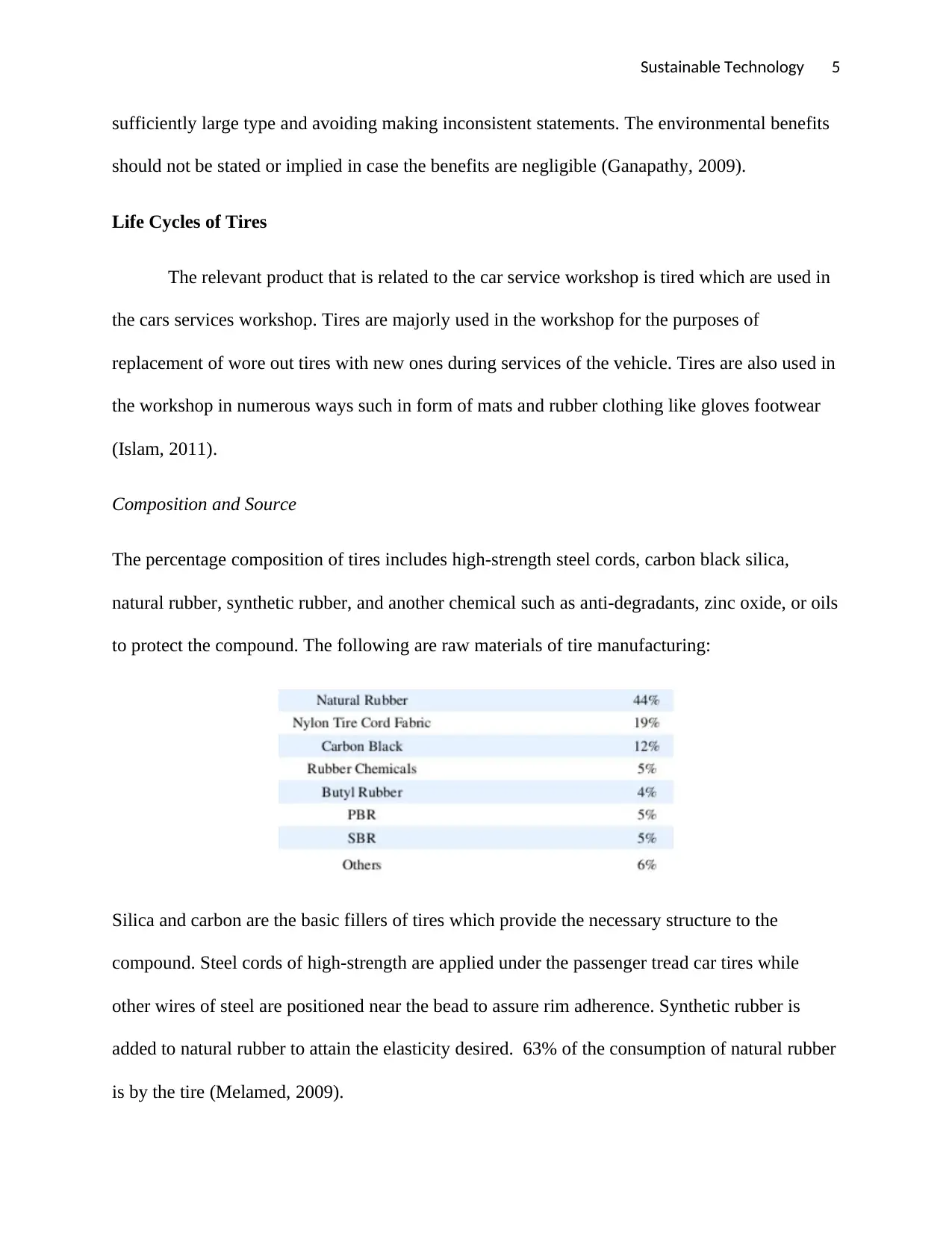
Sustainable Technology 5
sufficiently large type and avoiding making inconsistent statements. The environmental benefits
should not be stated or implied in case the benefits are negligible (Ganapathy, 2009).
Life Cycles of Tires
The relevant product that is related to the car service workshop is tired which are used in
the cars services workshop. Tires are majorly used in the workshop for the purposes of
replacement of wore out tires with new ones during services of the vehicle. Tires are also used in
the workshop in numerous ways such in form of mats and rubber clothing like gloves footwear
(Islam, 2011).
Composition and Source
The percentage composition of tires includes high-strength steel cords, carbon black silica,
natural rubber, synthetic rubber, and another chemical such as anti-degradants, zinc oxide, or oils
to protect the compound. The following are raw materials of tire manufacturing:
Silica and carbon are the basic fillers of tires which provide the necessary structure to the
compound. Steel cords of high-strength are applied under the passenger tread car tires while
other wires of steel are positioned near the bead to assure rim adherence. Synthetic rubber is
added to natural rubber to attain the elasticity desired. 63% of the consumption of natural rubber
is by the tire (Melamed, 2009).
sufficiently large type and avoiding making inconsistent statements. The environmental benefits
should not be stated or implied in case the benefits are negligible (Ganapathy, 2009).
Life Cycles of Tires
The relevant product that is related to the car service workshop is tired which are used in
the cars services workshop. Tires are majorly used in the workshop for the purposes of
replacement of wore out tires with new ones during services of the vehicle. Tires are also used in
the workshop in numerous ways such in form of mats and rubber clothing like gloves footwear
(Islam, 2011).
Composition and Source
The percentage composition of tires includes high-strength steel cords, carbon black silica,
natural rubber, synthetic rubber, and another chemical such as anti-degradants, zinc oxide, or oils
to protect the compound. The following are raw materials of tire manufacturing:
Silica and carbon are the basic fillers of tires which provide the necessary structure to the
compound. Steel cords of high-strength are applied under the passenger tread car tires while
other wires of steel are positioned near the bead to assure rim adherence. Synthetic rubber is
added to natural rubber to attain the elasticity desired. 63% of the consumption of natural rubber
is by the tire (Melamed, 2009).
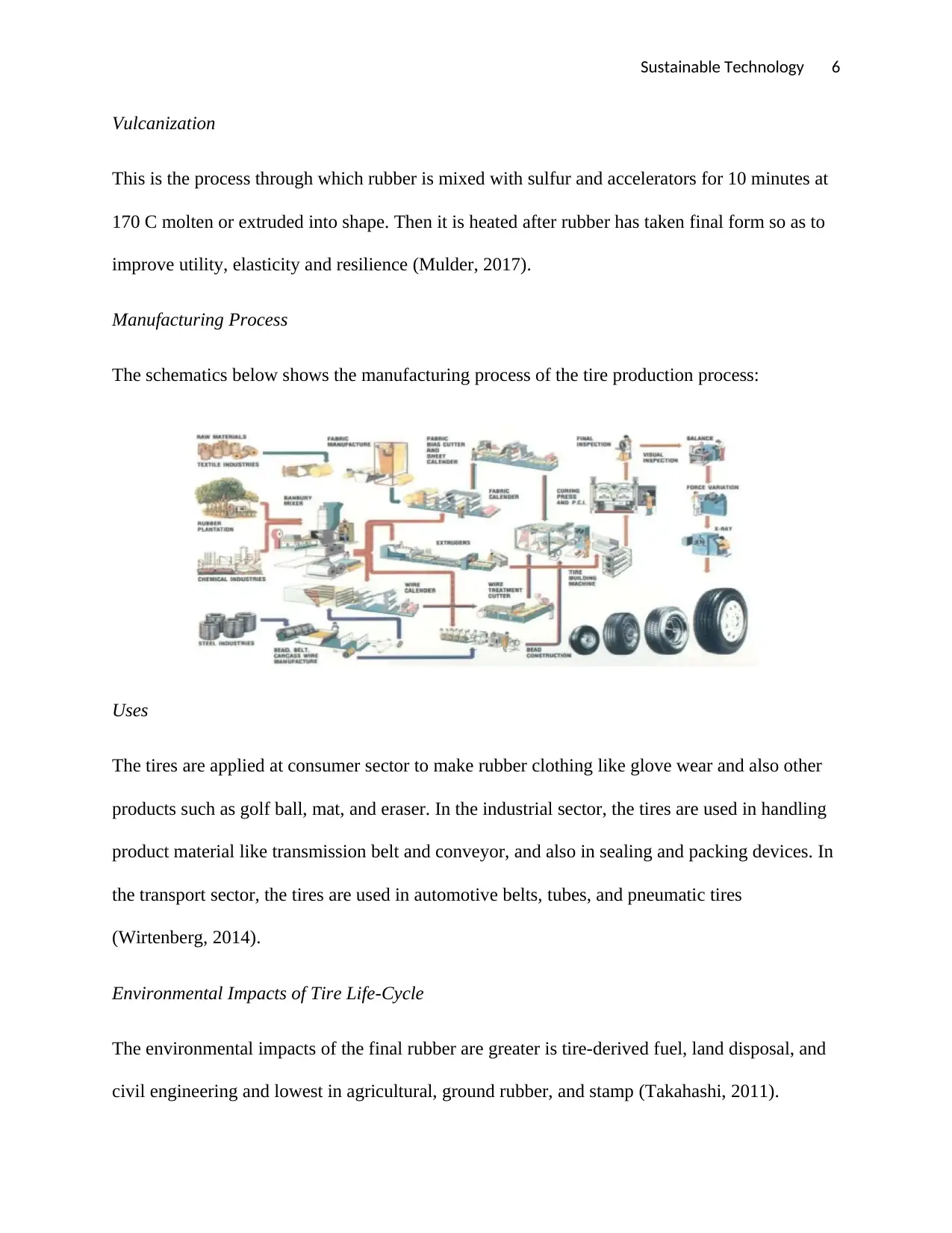
Sustainable Technology 6
Vulcanization
This is the process through which rubber is mixed with sulfur and accelerators for 10 minutes at
170 C molten or extruded into shape. Then it is heated after rubber has taken final form so as to
improve utility, elasticity and resilience (Mulder, 2017).
Manufacturing Process
The schematics below shows the manufacturing process of the tire production process:
Uses
The tires are applied at consumer sector to make rubber clothing like glove wear and also other
products such as golf ball, mat, and eraser. In the industrial sector, the tires are used in handling
product material like transmission belt and conveyor, and also in sealing and packing devices. In
the transport sector, the tires are used in automotive belts, tubes, and pneumatic tires
(Wirtenberg, 2014).
Environmental Impacts of Tire Life-Cycle
The environmental impacts of the final rubber are greater is tire-derived fuel, land disposal, and
civil engineering and lowest in agricultural, ground rubber, and stamp (Takahashi, 2011).
Vulcanization
This is the process through which rubber is mixed with sulfur and accelerators for 10 minutes at
170 C molten or extruded into shape. Then it is heated after rubber has taken final form so as to
improve utility, elasticity and resilience (Mulder, 2017).
Manufacturing Process
The schematics below shows the manufacturing process of the tire production process:
Uses
The tires are applied at consumer sector to make rubber clothing like glove wear and also other
products such as golf ball, mat, and eraser. In the industrial sector, the tires are used in handling
product material like transmission belt and conveyor, and also in sealing and packing devices. In
the transport sector, the tires are used in automotive belts, tubes, and pneumatic tires
(Wirtenberg, 2014).
Environmental Impacts of Tire Life-Cycle
The environmental impacts of the final rubber are greater is tire-derived fuel, land disposal, and
civil engineering and lowest in agricultural, ground rubber, and stamp (Takahashi, 2011).
⊘ This is a preview!⊘
Do you want full access?
Subscribe today to unlock all pages.

Trusted by 1+ million students worldwide
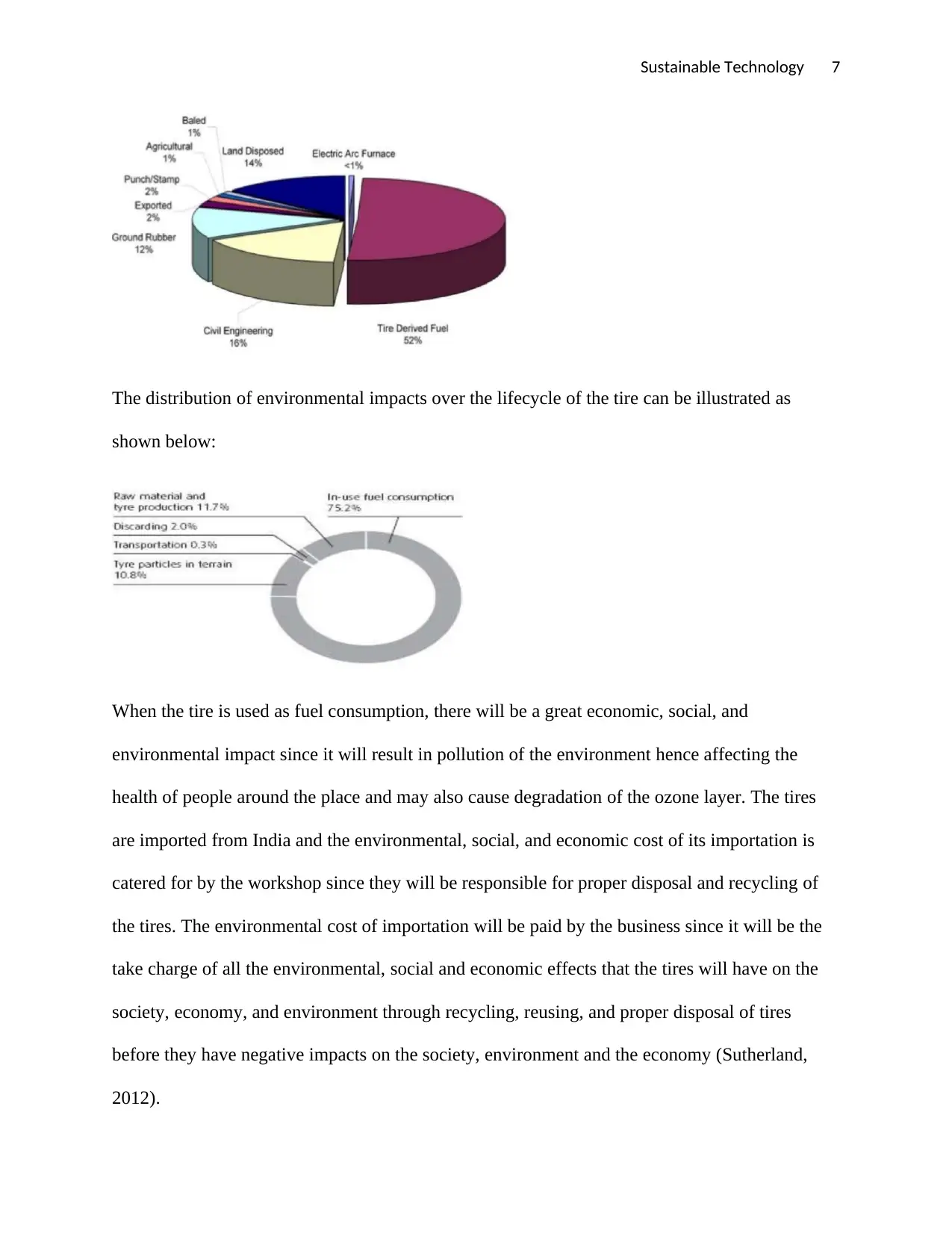
Sustainable Technology 7
The distribution of environmental impacts over the lifecycle of the tire can be illustrated as
shown below:
When the tire is used as fuel consumption, there will be a great economic, social, and
environmental impact since it will result in pollution of the environment hence affecting the
health of people around the place and may also cause degradation of the ozone layer. The tires
are imported from India and the environmental, social, and economic cost of its importation is
catered for by the workshop since they will be responsible for proper disposal and recycling of
the tires. The environmental cost of importation will be paid by the business since it will be the
take charge of all the environmental, social and economic effects that the tires will have on the
society, economy, and environment through recycling, reusing, and proper disposal of tires
before they have negative impacts on the society, environment and the economy (Sutherland,
2012).
The distribution of environmental impacts over the lifecycle of the tire can be illustrated as
shown below:
When the tire is used as fuel consumption, there will be a great economic, social, and
environmental impact since it will result in pollution of the environment hence affecting the
health of people around the place and may also cause degradation of the ozone layer. The tires
are imported from India and the environmental, social, and economic cost of its importation is
catered for by the workshop since they will be responsible for proper disposal and recycling of
the tires. The environmental cost of importation will be paid by the business since it will be the
take charge of all the environmental, social and economic effects that the tires will have on the
society, economy, and environment through recycling, reusing, and proper disposal of tires
before they have negative impacts on the society, environment and the economy (Sutherland,
2012).
Paraphrase This Document
Need a fresh take? Get an instant paraphrase of this document with our AI Paraphraser
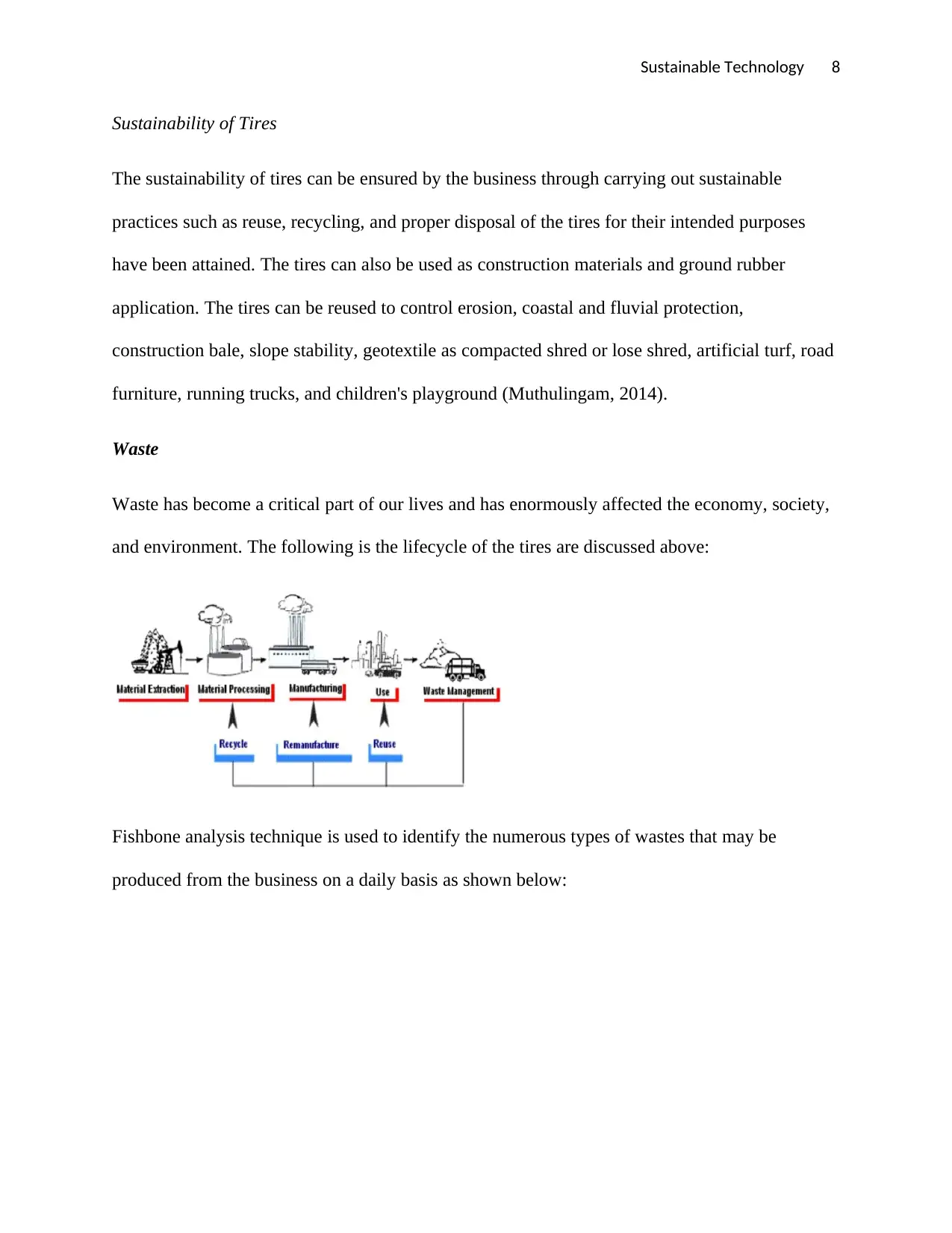
Sustainable Technology 8
Sustainability of Tires
The sustainability of tires can be ensured by the business through carrying out sustainable
practices such as reuse, recycling, and proper disposal of the tires for their intended purposes
have been attained. The tires can also be used as construction materials and ground rubber
application. The tires can be reused to control erosion, coastal and fluvial protection,
construction bale, slope stability, geotextile as compacted shred or lose shred, artificial turf, road
furniture, running trucks, and children's playground (Muthulingam, 2014).
Waste
Waste has become a critical part of our lives and has enormously affected the economy, society,
and environment. The following is the lifecycle of the tires are discussed above:
Fishbone analysis technique is used to identify the numerous types of wastes that may be
produced from the business on a daily basis as shown below:
Sustainability of Tires
The sustainability of tires can be ensured by the business through carrying out sustainable
practices such as reuse, recycling, and proper disposal of the tires for their intended purposes
have been attained. The tires can also be used as construction materials and ground rubber
application. The tires can be reused to control erosion, coastal and fluvial protection,
construction bale, slope stability, geotextile as compacted shred or lose shred, artificial turf, road
furniture, running trucks, and children's playground (Muthulingam, 2014).
Waste
Waste has become a critical part of our lives and has enormously affected the economy, society,
and environment. The following is the lifecycle of the tires are discussed above:
Fishbone analysis technique is used to identify the numerous types of wastes that may be
produced from the business on a daily basis as shown below:
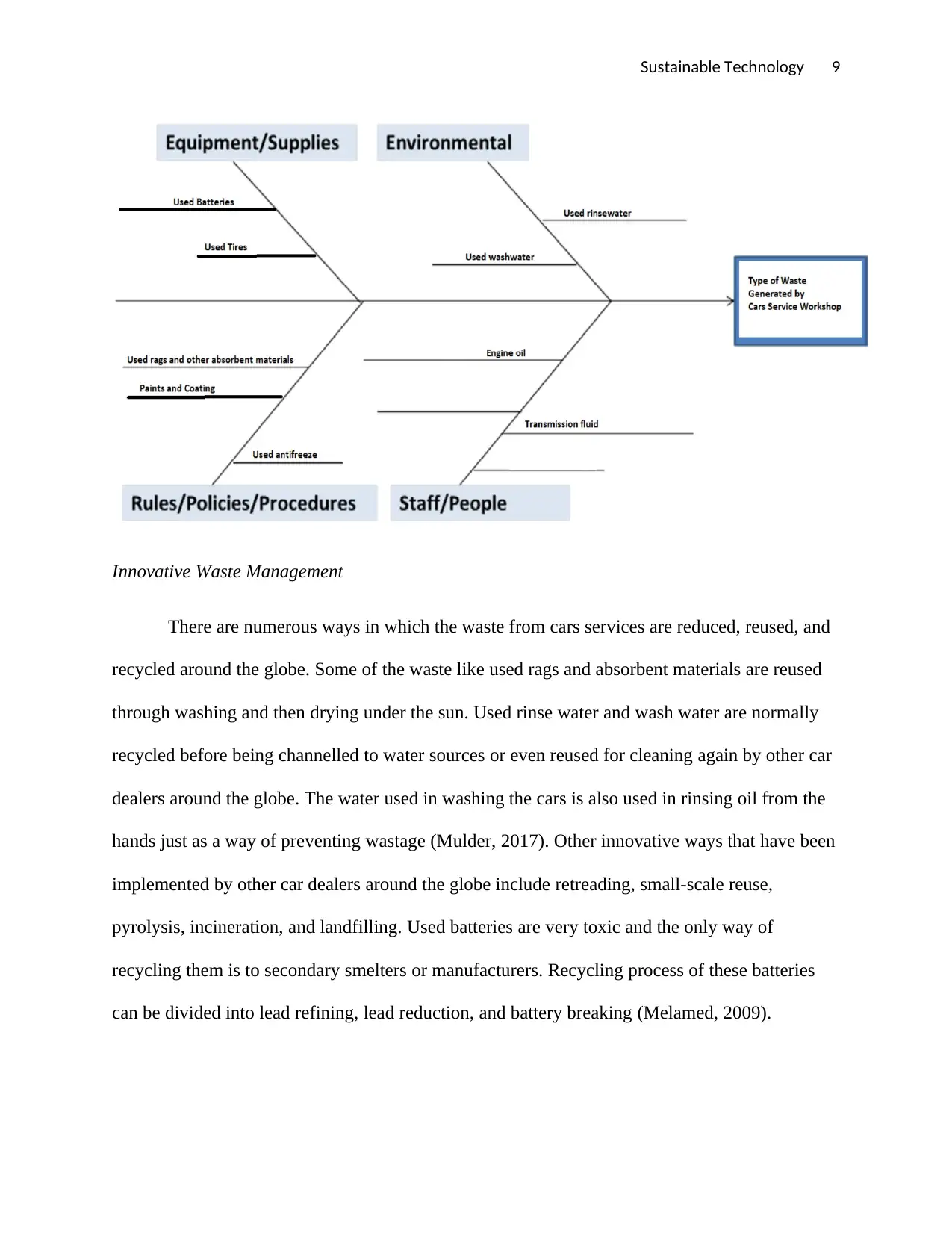
Sustainable Technology 9
Innovative Waste Management
There are numerous ways in which the waste from cars services are reduced, reused, and
recycled around the globe. Some of the waste like used rags and absorbent materials are reused
through washing and then drying under the sun. Used rinse water and wash water are normally
recycled before being channelled to water sources or even reused for cleaning again by other car
dealers around the globe. The water used in washing the cars is also used in rinsing oil from the
hands just as a way of preventing wastage (Mulder, 2017). Other innovative ways that have been
implemented by other car dealers around the globe include retreading, small-scale reuse,
pyrolysis, incineration, and landfilling. Used batteries are very toxic and the only way of
recycling them is to secondary smelters or manufacturers. Recycling process of these batteries
can be divided into lead refining, lead reduction, and battery breaking (Melamed, 2009).
Innovative Waste Management
There are numerous ways in which the waste from cars services are reduced, reused, and
recycled around the globe. Some of the waste like used rags and absorbent materials are reused
through washing and then drying under the sun. Used rinse water and wash water are normally
recycled before being channelled to water sources or even reused for cleaning again by other car
dealers around the globe. The water used in washing the cars is also used in rinsing oil from the
hands just as a way of preventing wastage (Mulder, 2017). Other innovative ways that have been
implemented by other car dealers around the globe include retreading, small-scale reuse,
pyrolysis, incineration, and landfilling. Used batteries are very toxic and the only way of
recycling them is to secondary smelters or manufacturers. Recycling process of these batteries
can be divided into lead refining, lead reduction, and battery breaking (Melamed, 2009).
⊘ This is a preview!⊘
Do you want full access?
Subscribe today to unlock all pages.

Trusted by 1+ million students worldwide
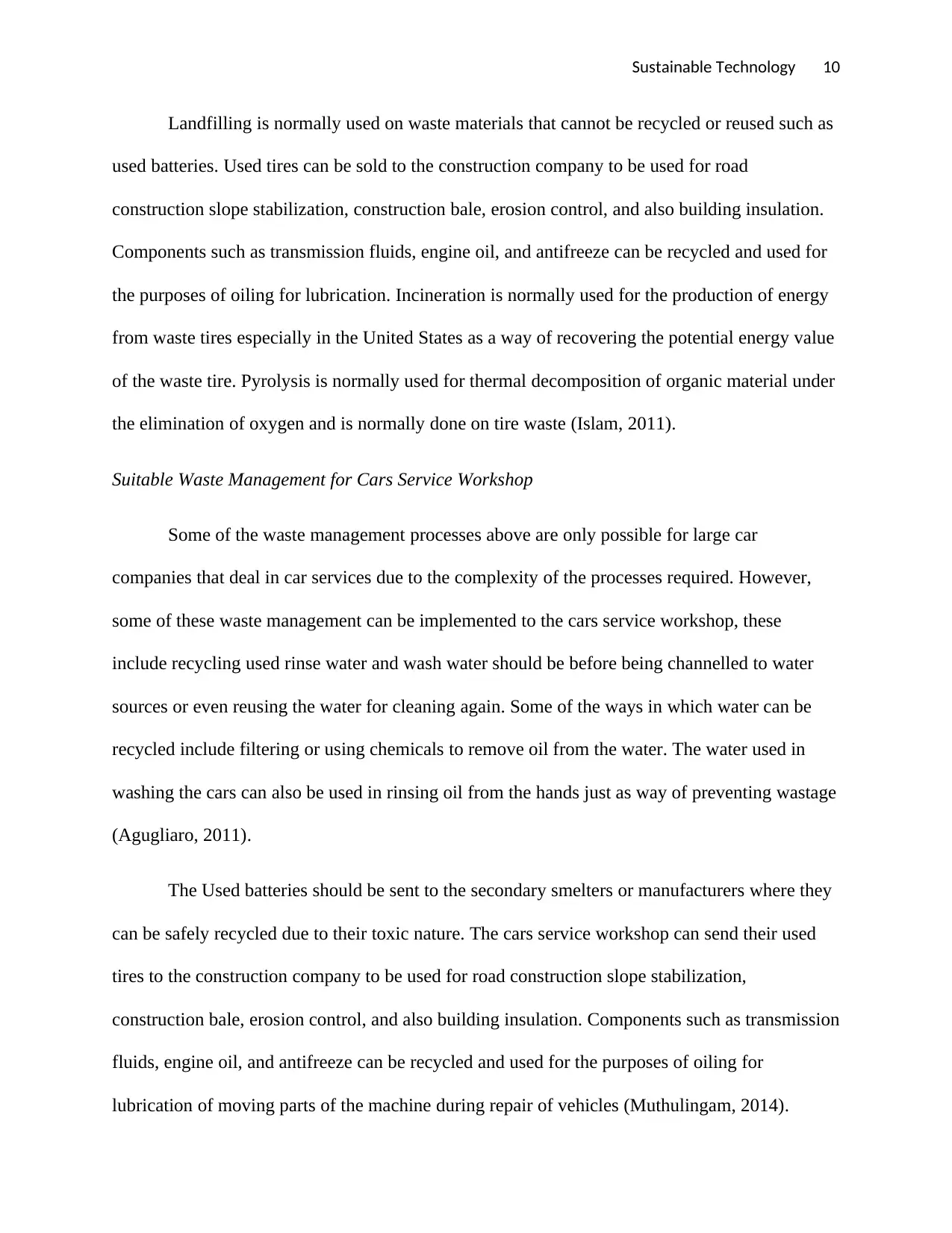
Sustainable Technology 10
Landfilling is normally used on waste materials that cannot be recycled or reused such as
used batteries. Used tires can be sold to the construction company to be used for road
construction slope stabilization, construction bale, erosion control, and also building insulation.
Components such as transmission fluids, engine oil, and antifreeze can be recycled and used for
the purposes of oiling for lubrication. Incineration is normally used for the production of energy
from waste tires especially in the United States as a way of recovering the potential energy value
of the waste tire. Pyrolysis is normally used for thermal decomposition of organic material under
the elimination of oxygen and is normally done on tire waste (Islam, 2011).
Suitable Waste Management for Cars Service Workshop
Some of the waste management processes above are only possible for large car
companies that deal in car services due to the complexity of the processes required. However,
some of these waste management can be implemented to the cars service workshop, these
include recycling used rinse water and wash water should be before being channelled to water
sources or even reusing the water for cleaning again. Some of the ways in which water can be
recycled include filtering or using chemicals to remove oil from the water. The water used in
washing the cars can also be used in rinsing oil from the hands just as way of preventing wastage
(Agugliaro, 2011).
The Used batteries should be sent to the secondary smelters or manufacturers where they
can be safely recycled due to their toxic nature. The cars service workshop can send their used
tires to the construction company to be used for road construction slope stabilization,
construction bale, erosion control, and also building insulation. Components such as transmission
fluids, engine oil, and antifreeze can be recycled and used for the purposes of oiling for
lubrication of moving parts of the machine during repair of vehicles (Muthulingam, 2014).
Landfilling is normally used on waste materials that cannot be recycled or reused such as
used batteries. Used tires can be sold to the construction company to be used for road
construction slope stabilization, construction bale, erosion control, and also building insulation.
Components such as transmission fluids, engine oil, and antifreeze can be recycled and used for
the purposes of oiling for lubrication. Incineration is normally used for the production of energy
from waste tires especially in the United States as a way of recovering the potential energy value
of the waste tire. Pyrolysis is normally used for thermal decomposition of organic material under
the elimination of oxygen and is normally done on tire waste (Islam, 2011).
Suitable Waste Management for Cars Service Workshop
Some of the waste management processes above are only possible for large car
companies that deal in car services due to the complexity of the processes required. However,
some of these waste management can be implemented to the cars service workshop, these
include recycling used rinse water and wash water should be before being channelled to water
sources or even reusing the water for cleaning again. Some of the ways in which water can be
recycled include filtering or using chemicals to remove oil from the water. The water used in
washing the cars can also be used in rinsing oil from the hands just as way of preventing wastage
(Agugliaro, 2011).
The Used batteries should be sent to the secondary smelters or manufacturers where they
can be safely recycled due to their toxic nature. The cars service workshop can send their used
tires to the construction company to be used for road construction slope stabilization,
construction bale, erosion control, and also building insulation. Components such as transmission
fluids, engine oil, and antifreeze can be recycled and used for the purposes of oiling for
lubrication of moving parts of the machine during repair of vehicles (Muthulingam, 2014).
Paraphrase This Document
Need a fresh take? Get an instant paraphrase of this document with our AI Paraphraser
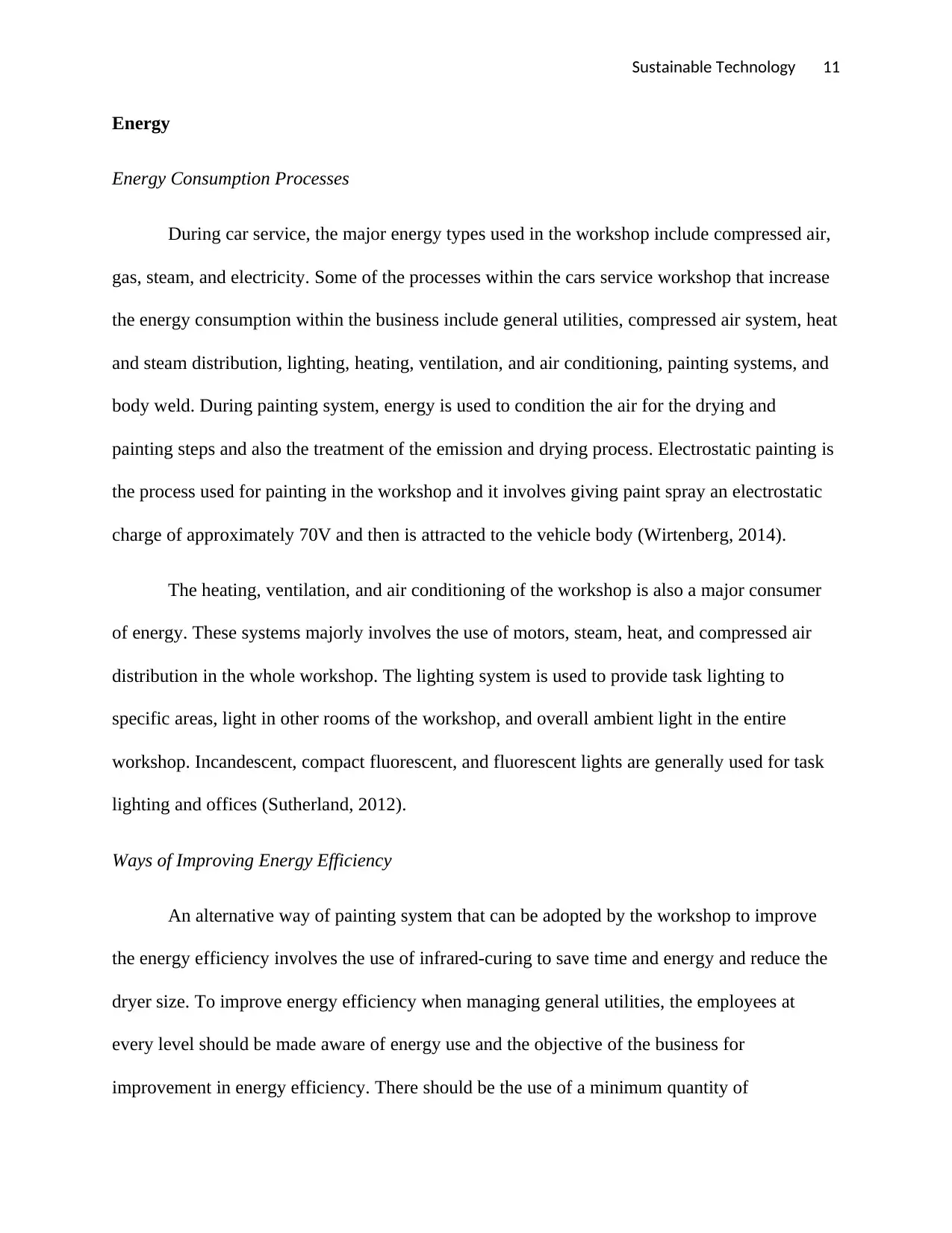
Sustainable Technology 11
Energy
Energy Consumption Processes
During car service, the major energy types used in the workshop include compressed air,
gas, steam, and electricity. Some of the processes within the cars service workshop that increase
the energy consumption within the business include general utilities, compressed air system, heat
and steam distribution, lighting, heating, ventilation, and air conditioning, painting systems, and
body weld. During painting system, energy is used to condition the air for the drying and
painting steps and also the treatment of the emission and drying process. Electrostatic painting is
the process used for painting in the workshop and it involves giving paint spray an electrostatic
charge of approximately 70V and then is attracted to the vehicle body (Wirtenberg, 2014).
The heating, ventilation, and air conditioning of the workshop is also a major consumer
of energy. These systems majorly involves the use of motors, steam, heat, and compressed air
distribution in the whole workshop. The lighting system is used to provide task lighting to
specific areas, light in other rooms of the workshop, and overall ambient light in the entire
workshop. Incandescent, compact fluorescent, and fluorescent lights are generally used for task
lighting and offices (Sutherland, 2012).
Ways of Improving Energy Efficiency
An alternative way of painting system that can be adopted by the workshop to improve
the energy efficiency involves the use of infrared-curing to save time and energy and reduce the
dryer size. To improve energy efficiency when managing general utilities, the employees at
every level should be made aware of energy use and the objective of the business for
improvement in energy efficiency. There should be the use of a minimum quantity of
Energy
Energy Consumption Processes
During car service, the major energy types used in the workshop include compressed air,
gas, steam, and electricity. Some of the processes within the cars service workshop that increase
the energy consumption within the business include general utilities, compressed air system, heat
and steam distribution, lighting, heating, ventilation, and air conditioning, painting systems, and
body weld. During painting system, energy is used to condition the air for the drying and
painting steps and also the treatment of the emission and drying process. Electrostatic painting is
the process used for painting in the workshop and it involves giving paint spray an electrostatic
charge of approximately 70V and then is attracted to the vehicle body (Wirtenberg, 2014).
The heating, ventilation, and air conditioning of the workshop is also a major consumer
of energy. These systems majorly involves the use of motors, steam, heat, and compressed air
distribution in the whole workshop. The lighting system is used to provide task lighting to
specific areas, light in other rooms of the workshop, and overall ambient light in the entire
workshop. Incandescent, compact fluorescent, and fluorescent lights are generally used for task
lighting and offices (Sutherland, 2012).
Ways of Improving Energy Efficiency
An alternative way of painting system that can be adopted by the workshop to improve
the energy efficiency involves the use of infrared-curing to save time and energy and reduce the
dryer size. To improve energy efficiency when managing general utilities, the employees at
every level should be made aware of energy use and the objective of the business for
improvement in energy efficiency. There should be the use of a minimum quantity of
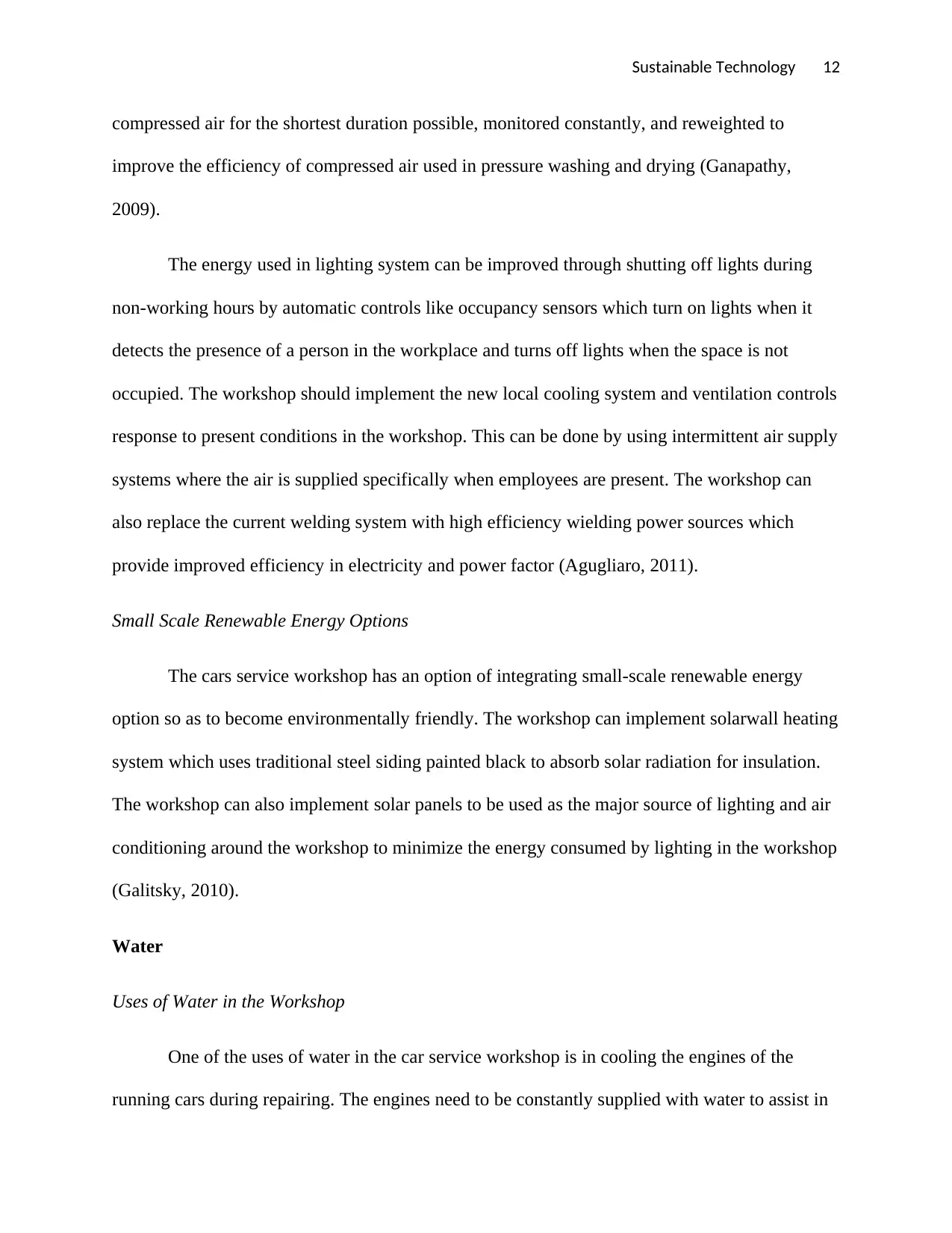
Sustainable Technology 12
compressed air for the shortest duration possible, monitored constantly, and reweighted to
improve the efficiency of compressed air used in pressure washing and drying (Ganapathy,
2009).
The energy used in lighting system can be improved through shutting off lights during
non-working hours by automatic controls like occupancy sensors which turn on lights when it
detects the presence of a person in the workplace and turns off lights when the space is not
occupied. The workshop should implement the new local cooling system and ventilation controls
response to present conditions in the workshop. This can be done by using intermittent air supply
systems where the air is supplied specifically when employees are present. The workshop can
also replace the current welding system with high efficiency wielding power sources which
provide improved efficiency in electricity and power factor (Agugliaro, 2011).
Small Scale Renewable Energy Options
The cars service workshop has an option of integrating small-scale renewable energy
option so as to become environmentally friendly. The workshop can implement solarwall heating
system which uses traditional steel siding painted black to absorb solar radiation for insulation.
The workshop can also implement solar panels to be used as the major source of lighting and air
conditioning around the workshop to minimize the energy consumed by lighting in the workshop
(Galitsky, 2010).
Water
Uses of Water in the Workshop
One of the uses of water in the car service workshop is in cooling the engines of the
running cars during repairing. The engines need to be constantly supplied with water to assist in
compressed air for the shortest duration possible, monitored constantly, and reweighted to
improve the efficiency of compressed air used in pressure washing and drying (Ganapathy,
2009).
The energy used in lighting system can be improved through shutting off lights during
non-working hours by automatic controls like occupancy sensors which turn on lights when it
detects the presence of a person in the workplace and turns off lights when the space is not
occupied. The workshop should implement the new local cooling system and ventilation controls
response to present conditions in the workshop. This can be done by using intermittent air supply
systems where the air is supplied specifically when employees are present. The workshop can
also replace the current welding system with high efficiency wielding power sources which
provide improved efficiency in electricity and power factor (Agugliaro, 2011).
Small Scale Renewable Energy Options
The cars service workshop has an option of integrating small-scale renewable energy
option so as to become environmentally friendly. The workshop can implement solarwall heating
system which uses traditional steel siding painted black to absorb solar radiation for insulation.
The workshop can also implement solar panels to be used as the major source of lighting and air
conditioning around the workshop to minimize the energy consumed by lighting in the workshop
(Galitsky, 2010).
Water
Uses of Water in the Workshop
One of the uses of water in the car service workshop is in cooling the engines of the
running cars during repairing. The engines need to be constantly supplied with water to assist in
⊘ This is a preview!⊘
Do you want full access?
Subscribe today to unlock all pages.

Trusted by 1+ million students worldwide
1 out of 15
Related Documents
Your All-in-One AI-Powered Toolkit for Academic Success.
+13062052269
info@desklib.com
Available 24*7 on WhatsApp / Email
![[object Object]](/_next/static/media/star-bottom.7253800d.svg)
Unlock your academic potential
Copyright © 2020–2025 A2Z Services. All Rights Reserved. Developed and managed by ZUCOL.





